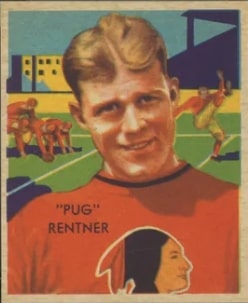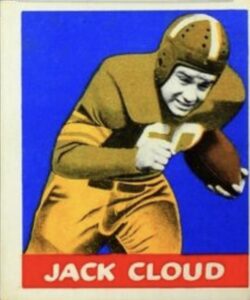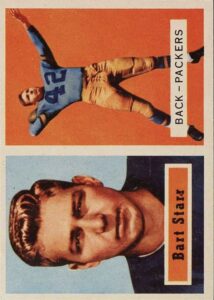
Gridiron Glory Represented on Cardboard
As the pro football season continues to serve up incredible plays and bone-rattling hits, we wanted to consider the history of this fantastic game as it has been captured on cardboard. The Hobby has more than a century’s worth of cards in this sport. Dive into the history of professional football trading cards here!
The Early History
The piece of cardboard that’s regarded as the very first football card hit the market decades before the first NFL game — in fact, its release was fewer than 20 years after the very first football game of any kind was staged in New Jersey.
The company behind the card, Goodwin & Co., was an American tobacco manufacturer, as were most other trading card creators in the 19th and 20th centuries. To promote the sale of its “Gypsy Queen” and “Old Judge” cigarettes, Goodwin stuffed cards featuring prominent American athletes into its packaging. Many of the athletes came from a few of America’s most popular sports at the time, like baseball, boxing, and tennis — indeed, most sports trading card sets released before 1935 featured athletes from all different sports. In this set, only one card featured a football player. His name was Harry Beecher.

Harry Beecher card
Beecher (sometimes called Henry Beecher — his birth name) was the starting quarterback and captain of the undefeated national champion Yale University football team in 1887. The team blanked seven of its nine opponents, ultimately outsourcing its competition by more than 500 points. Beecher never went on to play professionally, as there was no league in existence to support his talents. The Goodwin set preserves Beecher’s football legacy for eternity, along with a few brief news articles that offer additional context.
The NFL wasn’t founded until 1920, and the first set to exclusively feature football players wouldn’t come for an additional 15 years. The National Chicle Company, a gum producer based in Massachusetts, created it. Around this same time, National Chicle was also producing baseball cards — it printed two sets, Diamond Stars and Batter Up, starting the year prior in 1934. Though the company set out to create a 240-card set — and stated those intentions on every card back — only 36 ever made it to market.
1935 National Chicle Football Cards
The set largely featured NFL players, but it wasn’t totally exclusive. Former Notre Dame head coach Knute Rockne has his own card (one of the most sought-after in the set), and Hall-of-Famer Bronko Nagurski is featured in his University of Minnesota uniform (though his card back referenced his NFL team at the time, the Chicago Bears).
Just Getting Started
Before 1948, football card releases were sporadic and inconsistent. But Bowman and Leaf’s battle for trading card supremacy changed that — and ever since 1948, collectors have been able to chase at least one professional football card set each year.
1948 Bowman Football looked a lot like the company’s landmark baseball set from the same year — in both, you’ve got black-and-white photography encased by a thin white border with no names, teams, or logos otherwise shown on the front. The 108-card set consists of professionals only, no collegiate stars. The set has often been derided by collectors looking for pristine copies of those vintage cards because it was notorious for some centering issues (plus the white borders often showed their age with yellowing). But in a guide for The Cardboard Connection, Chris Stufflestreet notes that because it was long overlooked, it’s much more affordable than other vintage sets.
1948 Bowman Football
Bowman’s rival, Leaf, released a competitive set at about the same time — and unlike Bowman, its set included college football stars. There are also a few key differences in the designs — although the players’ bodies are in black-and-white, Leaf added color to uniforms, helmets, footballs, and backgrounds to make the artwork pop.
Given that the sets from Bowman and Leaf were the first in 13 years, nearly every card in the set was the player’s “rookie” card. A few highlights included quarterback Sammy Baugh (who appeared in both sets) and two-way player Chuck Bednarik (the first overall pick in the 1949 NFL Draft, depicted in the Leaf set as a University of Pennsylvania player).
1948 Leaf Football
Topps Gets Under Center
Bowman continued to produce NFL cards in the first half of the 1950s, but its hold on the league’s licensing rights ended with Topps’s acquisition in 1956. Topps’ first NFL release, 1956 Topps Football, kickstarted a run of annual pro football card drops that lasted almost 60 years.
And although 1956 was the first set, it’s the set from the following year that’s still making waves today. Topps’s 1957 football follow-up is one of its best-known vintage sets due to its legendary rookie class, including Hall-of-Fame quarterbacks Bart Starr and Johnny Unitas. Overall, 31 players featured in the 154-card checklist — like running back Tommy McDonald and cornerback Dick “Night Train” Lane — are also enshrined in Canton.
1957 Topps Football
But 1957 Topps Football also stands out for its design. The colorful card set is entirely horizontal, and each card features two photos of the featured player — one tightly-cropped headshot and one action photo. The background colors behind those dual photographs differ, corresponding to each player’s team colors.
Collectors still have their eyes on 1957 Topps Football, especially those Unitas and Starr RCs. In good condition, a graded copy of either card can easily fetch over $1,000 — and in mint condition, you need to add a few zeroes. In 2016, one buyer forked over more than $140,000 for a coveted Unitas RC.
Five years later, Topps seemingly channeled that two-photo, horizontally-oriented design for 1962 Topps Football. Known today for a few of its biggest RCs, including quarterback Fran Tarkenton and running back Ernie Davis (the first Black winner of the Heisman Trophy), the 1962 also had a very popular insert: “Football Bucks.”

Out went George Washington and Abraham Lincoln, et al.; in went Jim Brown and Mike Ditka. 1962 Topps Football Bucks created fake dollar bills (in various denominations) featuring the likenesses of 25 different players. The faux dollars included player trivia and an illustration of the player’s home stadium — Ditka’s card, for example, includes a model of Wrigley Field, which was the stomping grounds of the Bears at the time.

Going Head-to-Head
To a greater extent than its peers in American professional sports, the NFL has frequently dealt with challenger leagues, none of which posed a more serious threat than the American Football League of the 1960s. Though a number of leagues (a few of which bore the same name) tried to take on the NFL in the 20th century, this iteration of the AFL was by far the most successful. It attracted attention for putting more attention on the offense, and this exciting style of play earned the league major TV contracts with ABC and NBC. After a decade of bitter competition for the best players and cultural supremacy, the AFL and NFL would eventually merge into one league — but not before a few landmark AFL card sets were released.
The first was the 1960 Fleer Football set, which debuted alongside the AFL in the fall of that year. Since no AFL games had taken place during the design phase of the production process, the team behind the cards made it work with the images they had access to — usually relying on posed action shots or images from the players’ college days. Quarterback Jack Kemp highlights a fairly lackluster rookie class without many other standouts for collectors to chase.
But Fleer’s 1960 set is notable for a different reason: it highlighted seven of the AFL’s eight head coaches, like Baugh (who retired and became the head coach of the New York Titans) and passing game innovator Sid Gillman, on their own cards. It would be the last time coaches were featured so prominently until the 1989 Pro Set football series.
“And looking back, what a group it was,” wrote Rich Mueller for Sports Collectors Daily about Fleer’s class of head coaches. “The ’60 Fleer set might be the only trading card set in history where the coaches overshadow the players.”
1960 Fleer AFL Head Coaches
Of course, Topps would also get in on the AFL action. 1961 Topps Football featured players from both the AFL and the NFL, but in the two years following that set, Topps focused exclusively on NFL teams and players. That changed in 1964 when Topps lost its NFL license to the Philadelphia Gum Company and turned its attention back to the AFL.
From 1964 to 1967, Topps created AFL-only sets; the most notable set from that era is 1965 Topps Football, for a few different reasons. First, it includes the legendary rookie card of quarterback Joe Namath. A mint Namath RC once sold for over $250,000; even copies in less-than-stellar condition will go for more than $1,000. In addition, the set is notable because the cards in it are oversized; for that, they earned the affectionate nickname “Tall Boys.”
While 1967 marked the last football card set that solely featured players from the AFL, it wasn’t the last time we’d see those players. In 1968 and 1969, Topps returned to the dual NFL-AFL focus. The 1969 football season would be the last for the AFL, which agreed to a merger with the NFL in 1966 that was scheduled to take place before the 1970 season began. The 10 AFL franchises and their players became part of the NFL, and thus, they were featured in NFL card sets from 1970 onward.
Entering the Modern Era
The first notable post-merge set for today’s collector is 1972 Topps Football. In the few years prior to 1972, Topps had released its cards in two 132-card series for a total of 263 cards (the checklist was printed in each series, counting only once). And while it appeared that trend would continue in 1972, Topps unexpectedly dropped a third series of cards late in the year. It was drastically smaller than the first two series, and the lack of availability over the years indicates that the third series wasn’t printed as frequently, either. That makes those cards from the third series, like Namath’s Pro Action card, especially valuable.
Although Topps pivoted away from the AFL when the league ceased to exist in 1970, that doesn’t mean the company was finished with upstart NFL competitors. About a decade later, in 1984, Topps released a set for the United States Football League, better known as the USFL. The league was ultimately short-lived — it attracted top college players and won a key antitrust lawsuit against the NFL, but the USFL burned money, so it only survived for three seasons. Despite the league’s short lifespan, 1984 Topps USFL Football is a hobby classic. The set includes the first cards of a few players who eventually became NFL legends, including quarterback Steve Young and defensive end Reggie White. (Mint copies of each have sold for over $10,000 in recent years.) The card set’s patriotic design plays off the league logo, which prominently featured the stars and stripes.
In the 1990s, competition in the card marketplace heated up. In addition to regular Topps and Bowman releases, a handful of other companies created their own football card sets — Upper Deck, Fleer, Score, Stadium Club, and Pro Line, to name a few. Through it all, Topps continued to make an impact in a crowded space, primarily through its premium product, Topps Chrome.
Ready for Kickoff
A new football season always gets fans excited about the future, but it also presents a perfect opportunity to get excited about the past. These vintage sets are excellent opportunities for collectors, new and old, to share in their love of the game and the Hobby. Trading cards beautifully preserve athletic legacies, and staying in the loop on the game’s history only helps inform its next steps.




















































